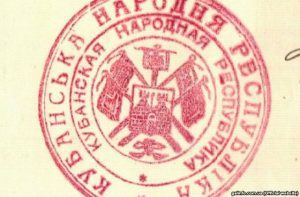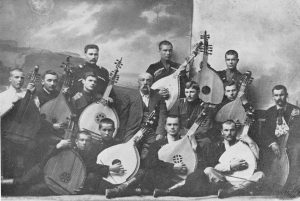
- There’s a rather widespread Ukrainian stereotype that “Kuban is Ukraine”. In fact, everything was very ambiguous a hundred years ago. The Kuban was very heterogeneous. The population was divided into Cossacks and non-Cossacks, while the North Caucasian peoples constituted a separate group. Moreover, the Cossack population was also divided into Black Sea Cossacks (Chornomortsi), who were descendants of the Zaporizhzhia Cossacks, and “Liniytsi” (Line Cossacks), who were mostly from Russian regions (Don Cossacks). How did these peoples interact with each other?

Dmytro Bilyy: Back then, in the 19th
century, if you said that Kuban wasn’t Ukraine, people would look at you in surprise. According to the census of 1897, 83%-86% of the Black Sea Cossacks were Ukrainian. The region was definitely Ukrainian.
The Kuban Army was formed in 1860 when the Black Sea Cossack Army joined with the Line (Russian) Cossack Army, which had several divisions with 35%-40% of Ukrainians.
- How strong was the Ukrainian component? After all, the state itself - the Kuban People’s Republic - identified itself as a territory, and not by nationality.
Andriy Ivanets: Most of the people residing in Kuban were Ukrainian, although there was a rather large Russian population; there were also mountain peoples from the Caucasus regions.
But, the overwhelming majority were Ukrainians, so during the Ukrainian Revolution of 1917-1921, many political forces considered Kuban part of a future autonomous Ukraine.
The All-Ukrainian National Congress, which was held in Kyiv in April 1917, re-organized the Central Rada into a nation-wide body; Kuban Cossack Stepan Erastov attended and voted at this congress.
When the Ukrainian Central Rada first approached the Provisional Government in Petrograd to establish Ukraine’s autonomy, it was specified that the Kuban should be included as part of Ukraine. But, due to the fact that a specific political process was being developed in Kuban region, the Central Rada decided to limit the federation to nine Ukrainian provinces in the Dnipro region.

Going back a bit in time… after the Bolshevik Revolution in 1917, the legitimate central government disappeared and the Kuban was forced to decide its political future. One of the options was to unite with other Cossack regions.
At the end of 1917, the Kuban joined the South-Eastern Union of the Cossack Army, mountain nations and free peoples of the steppe. A little later, the Kuban People’s Republic was proclaimed and took up the fight against the Bolsheviks.
At a meeting of the Kuban Council, the members decided to appeal to the Ukrainian People’s Republic (UNR) to constitute a political federation.
However, this idea was not realized due to the complex political situation. Bolshevik divisions started retreating from the Caucasian front and Russian White Guard troops entered the Kuban. However, as the Bolsheviks had greatly undermined Kuban’s freedom and enfeebled the Kuban Republic, its leadership was forced to leave the capital Katerynodar (ex-Yekaterinodar, re-named Krasnodar in 1922), and soon met and signed a treaty with the White Guard.
However, contacts and negotiations with Ukraine continued. On April 29, 1918, a coup d’etat toppled the Ukrainian People’s Republic and Pavlo Skoropadsky became Hetman of Ukraine. A delegation from the Kuban People’s Republic, headed by Mykola Ryabovol, chairman of the Kuban Legislative Council and speaker of the Kuban Parliament, arrived in Kyiv. From the memoirs of the Ukrainian Foreign Minister, Dmytro Doroshenko, we know that both republics agreed that the Kuban should unite with Ukraine, and negotiations were underway as to the form of this union – was it to be a federation or would Kuban become an autonomous entity?

Dmytro Bilyy:
We should understand the context of those years. Many pro-independence movements emerged after the break-up of the Russian Empire and sought to establish independent territories. An anti-Bolshevik uprising began in the Kuban in April 1918, so a lot depended on who would send the first troops to help them out.
When the representative of the Ukrainian Central Rada, Mykola Halahan, arrived at Katerynodar, he wrote that in Kyiv he saw a state without an army, and in Kuban - an army without a state. People came from all over to fight there…
- It seems that even deputies of the Kuban parliament and members of the government took part in the fighting.
Dmytro Bilyy: There was an epic battle when the Bolsheviks advanced and the Kuban army retreated from Katerynodar. Four bandura players sat near the battle field and played as members of the Kuban Council launched counterattacks against the Bolshevik forces. Bandurists were sacred for the Kuban.


Andriy Ivanets: There were many regions vying for independence and self-determination. As the Russian Empire did not allow freedom of speech or movement, different options were possible for the Kuban after 1917: to unite with Ukraine into a single modern national entity, to create its own Cossack Kuban nation, to build an independent Cossack region united with other neighbouring Cossack entities - Don and Terek Cossacks - or to become part of the Great Russian National Project.

Mykola Ryabovol, speaker of the Kuban Parliament, was attracted to Ukraine; Ivan Makarenko advocated for Kuban independence, and representatives of the Line (Russian) Cossacks looked towards Moscow and the Great Russian Project.
However, Kuban failed to set up an independent state. The region found itself imprisoned between Red and White Russia. Finally, it fell to the Bolsheviks; mass repressions in the 1930s resulted in the arrest and execution of over 1,500 Ukrainian-speaking intellectuals from Krasnodar, and in 1932-33, forced collectivization led to a devastating famine that greatly affected the Ukrainian population of the Kuban. The physical destruction of all aspects of Ukrainian culture and the Ukrainian population, i.e. ethnic cleansing, Russification, the Holodomor of 1932-33 and 1946-7, and other tactics used by the communist government led to a catastrophic decline of ethnic Ukrainians in the Kuban.
- The Kubanians were strongly opposed to communism and fought against the Bolshevik forces in the Russian Civil War (November, 1918 – October, 1922). What do we know about the Kubanians fighting in the Ukrainian national liberation movement?
Dmytro Bilyy: Kubanians contributed a lot: commander Yushkevych and his Kuban infantry divisions joined the Ukrainian People’s Army; Andriy Charnota led the partisans fighting for the Kholodny Yar Republic (1919-1922).

It’s truly tragic that political leaders of that time were unable to integrate the Kuban into Ukraine.
Native languages in the Kuban Region according to the 1897 census
| Language | Percentage |
| Ukrainian | 47.36 % |
| Russian | 42.56 % |
| Circassian | 2.01% |
| Karachay | 1.4% |
| Other | 6.67% |
Peoples residing in the Kuban Region according to the 1926 census
| Nationality | Number | Percentage |
| Ukrainians | 915,450 | 62.2 % |
| Russians | 498,102 | 33.8 % |
| Armenians | 21,023 | 1.4 % |
| Belarusians | 8,434 | 0.6 % |
| Germans | 7,255 | 0.5 % |
Excerpt from documentary "Kubanski Kozaky" by Valentyn Sperkach (1992) (in Ukrainian,Russian)
[embedyt] https://www.youtube.com/watch?v=vwudT3y5zuU[/embedyt]


